The Colossal Statue of Mars (Pyrrhus) housed in the Capitoline Museums stands as one of the most impressive surviving sculptures from ancient Rome. Dating back to the 2nd century AD, this monumental piece is a testament to the artistic and technical mastery of Roman sculptors. Carved with exceptional precision and detail, the statue captures the essence of Mars, the Roman god of war, in a manner that reflects both the cultural and military significance of his role in Roman society.

This particular statue, often referred to as Pyrrhus, showcases the grandeur and strength associated with Mars. Towering over spectators, the imposing figure is a striking representation of divine authority, embodying the ideals of power, protection, and conquest that defined Roman civilization. Sculpted from high-quality marble, the statue exhibits the distinct craftsmanship characteristic of the era, with meticulous attention to the figure’s anatomy, posture, and attire. Every element of the piece contributes to a sense of dominance and divine might, making it one of the most revered depictions of Mars in Roman art.
One of the most remarkable details of this sculpture is the Calcei of Mars—the distinctive footwear that immediately draws the observer’s attention. These intricately designed shoes are not just a mere artistic embellishment; they serve as a significant cultural marker, symbolizing the elevated status of Mars. In ancient Rome, footwear played an essential role in distinguishing social class and rank, and the calcei worn by Mars in this statue reflect his supreme divine and martial authority. The elaborate patterns carved into the footwear reveal the extraordinary skill of Roman artisans, demonstrating their ability to transform even the smallest elements of a statue into a visual narrative of power and prestige.
The symbolism of Mars in Roman society cannot be overstated. As the god of war, he was one of the most revered deities in the Roman pantheon, often associated with military success, the protection of the state, and the unbreakable strength of Rome’s legions. The presence of this colossal statue in a prominent location would have been a constant reminder to Roman citizens and military leaders of their duty to uphold the might of their empire. The sheer scale of the statue reinforces the notion that Mars was not merely a deity to be worshipped, but an active force in ensuring the stability and dominance of Rome.
The Roman interpretation of Mars was deeply rooted in the city’s origins and history. Unlike his Greek counterpart Ares, who was often depicted as a chaotic and aggressive force, Mars was revered as a more disciplined and honorable god. He was believed to be the father of Romulus and Remus, the legendary twin founders of Rome, which further cemented his divine connection to the destiny of the Roman people. This direct association with the city’s foundation made Mars an integral figure in Roman mythology and religious practices. His festivals, temples, and military dedications played a crucial role in public and political life, reinforcing his status as a divine protector of Rome.
The artistic techniques used in the creation of the Colossal Statue of Mars highlight the advancements of Roman sculpture during the 2nd century AD. By this period, Roman sculptors had mastered the ability to blend realism with idealization, producing lifelike yet glorified representations of gods and emperors. The details in the statue’s musculature, stance, and expression reveal the sculptor’s deep understanding of human anatomy and movement. The flowing drapery, another signature of Roman sculpture, is carved with such skill that it appears almost weightless despite being made of stone. The balance between strength and grace in this depiction of Mars underscores the artistic philosophy of the time, which sought to convey both the power and the divine perfection of Rome’s most important figures.
The Capitoline Museums, where the statue is currently housed, hold some of the most significant relics of ancient Rome. Established in 1471 by Pope Sixtus IV, the museums contain a vast collection of sculptures, inscriptions, and artifacts that offer invaluable insights into Roman history and art. The Colossal Statue of Mars remains one of the museum’s highlights, drawing scholars, historians, and art enthusiasts from around the world. Its presence in the museum allows for detailed study and appreciation of the artistic and historical narratives embedded in the sculpture.
Beyond its aesthetic and cultural significance, the statue also provides a glimpse into the religious beliefs of ancient Romans. Mars was not only a war deity but also associated with agriculture, fertility, and the cycles of nature, particularly in Rome’s early history. His role evolved over time to become primarily that of a warrior god, but remnants of his earlier associations remained evident in certain rituals and festivals dedicated to him. This duality of Mars as both a guardian of war and a nurturer of prosperity is subtly reflected in the statue, as its grandeur conveys both destructive power and protective strength.
The Colossal Statue of Mars (Pyrrhus) at the Capitoline Museums continues to captivate modern audiences, serving as a powerful reminder of Rome’s artistic ingenuity, military dominance, and cultural legacy. It stands as an enduring symbol of the values that shaped one of the greatest civilizations in human history. Through its intricate craftsmanship and imposing presence, the statue tells a story that extends far beyond its marble surface—a story of conquest, divine authority, and the unshakable spirit of Rome.





